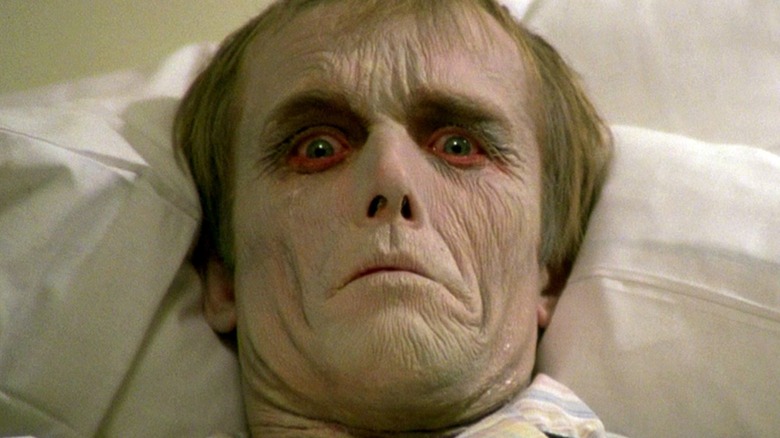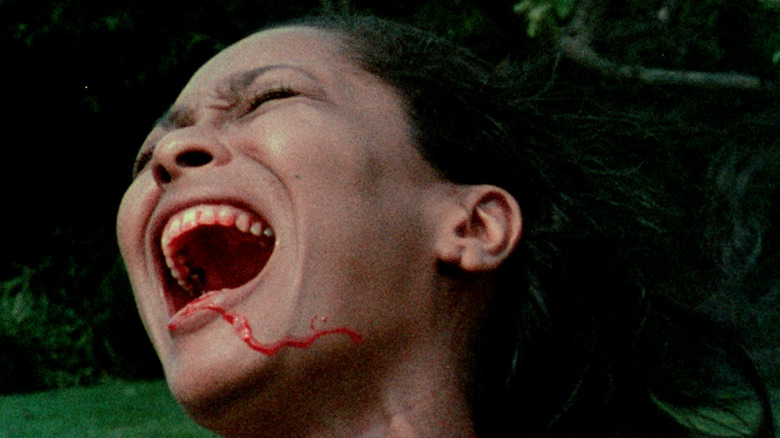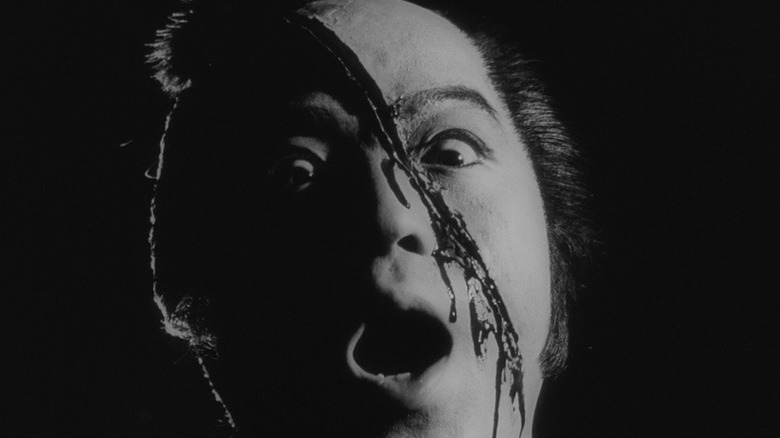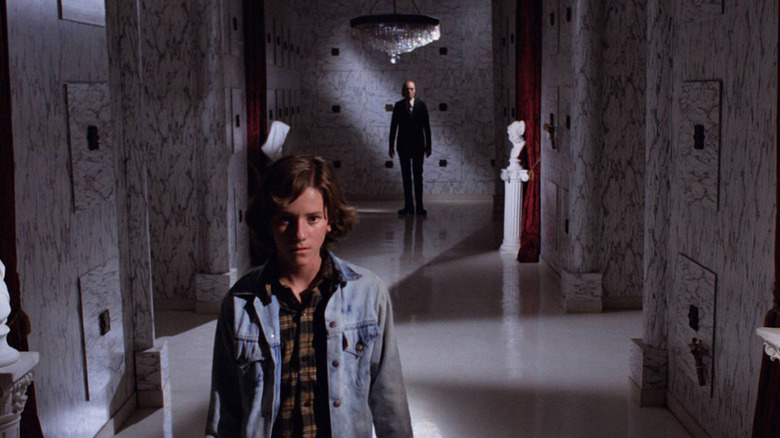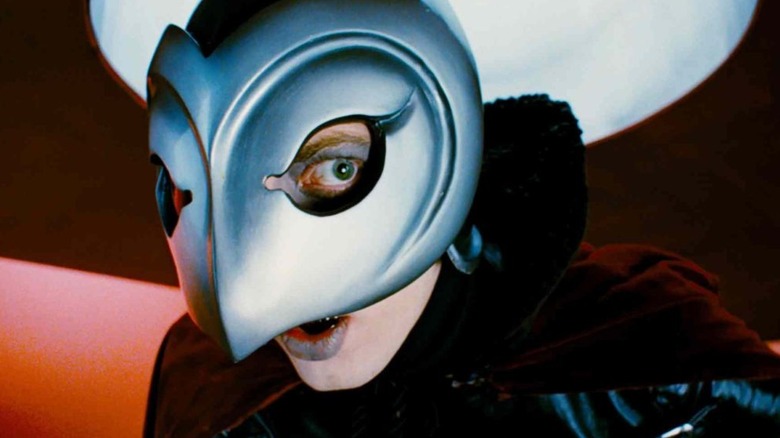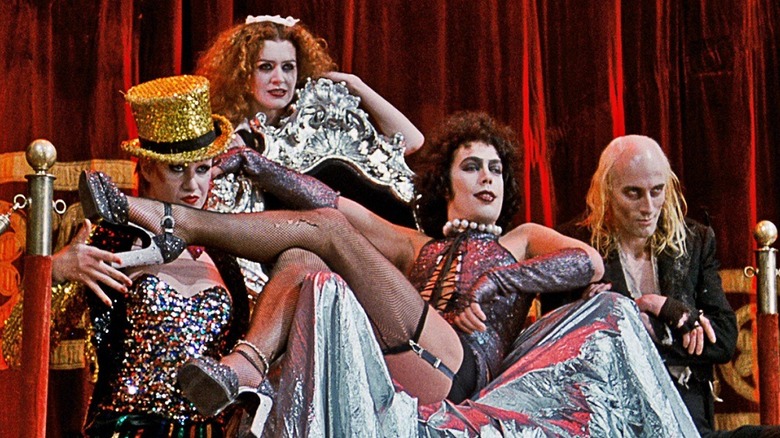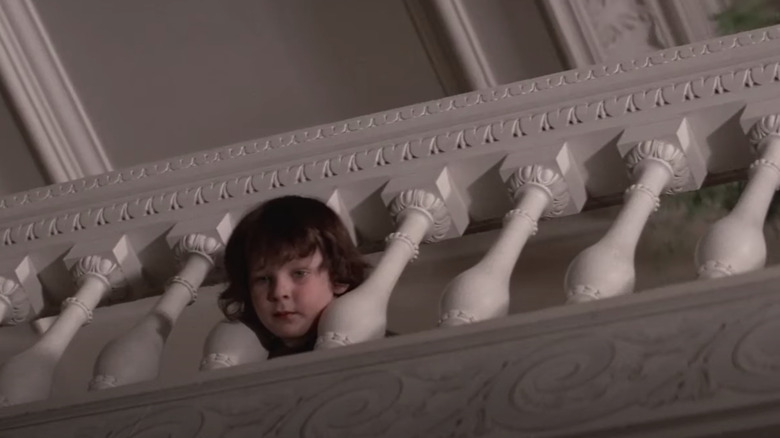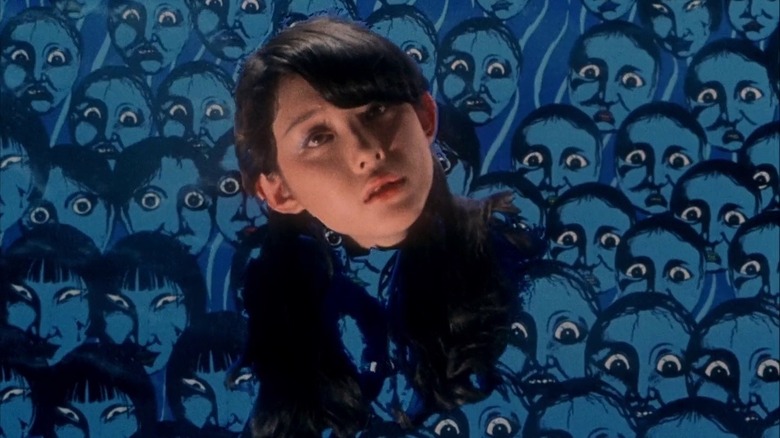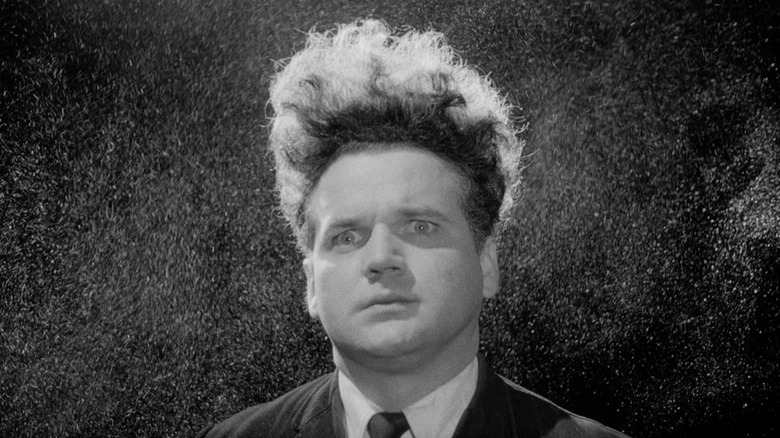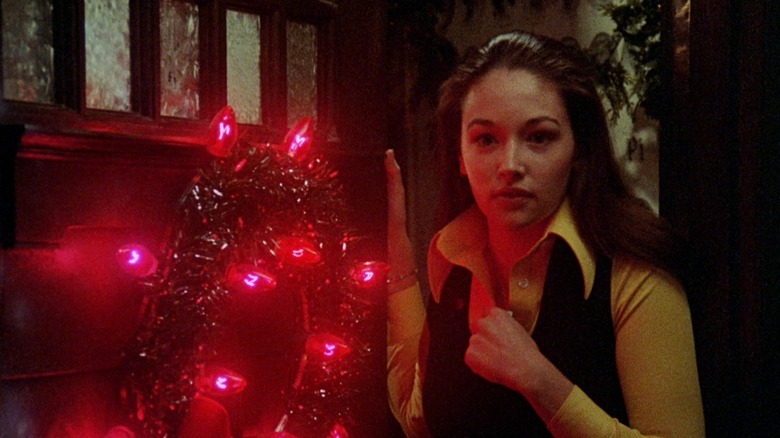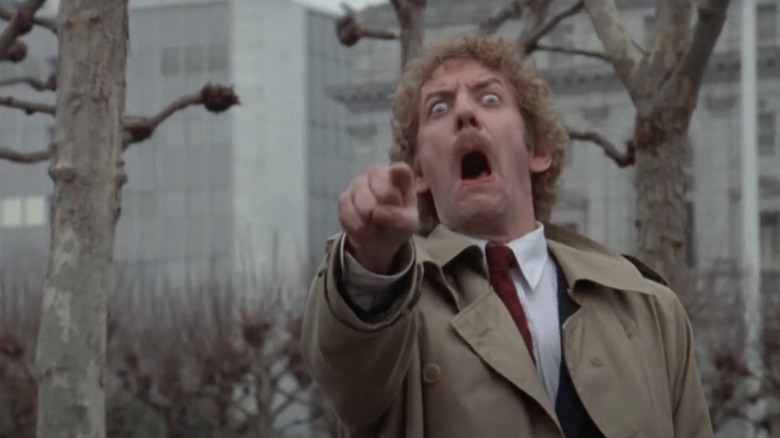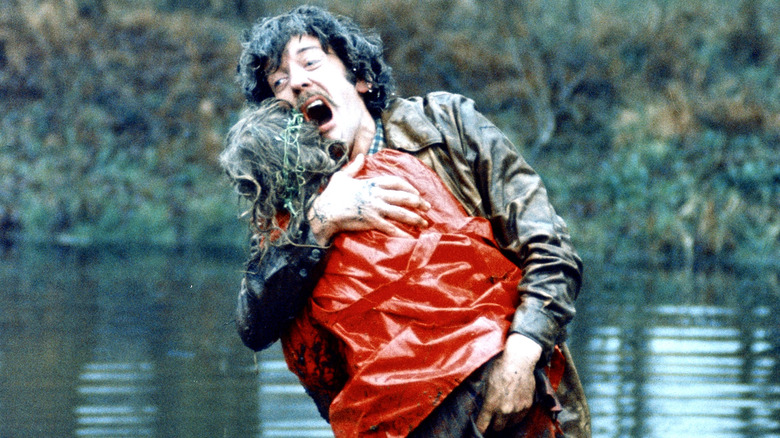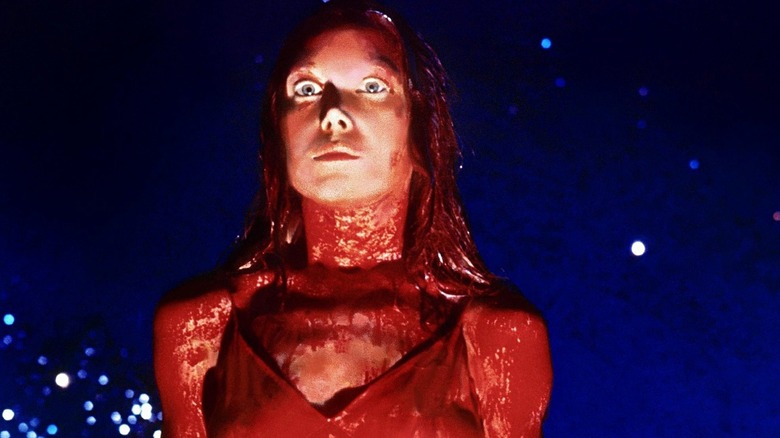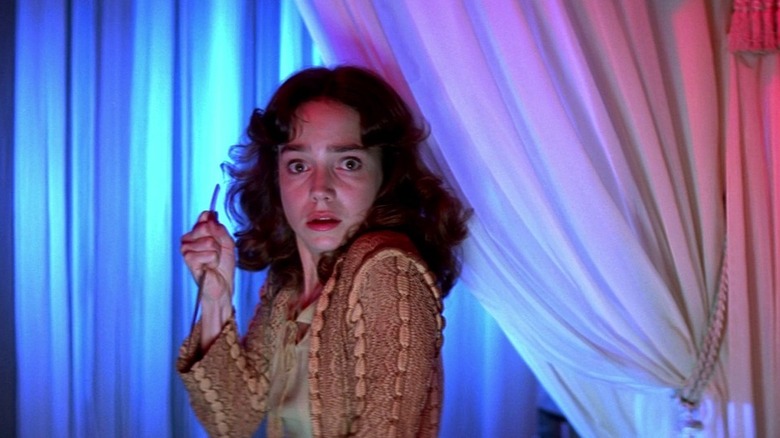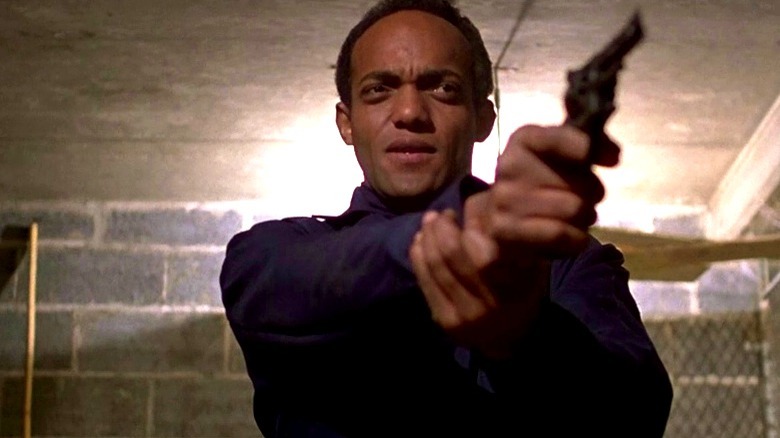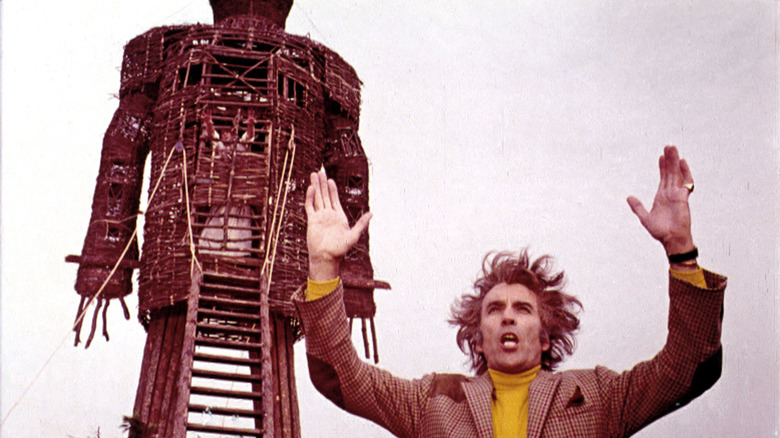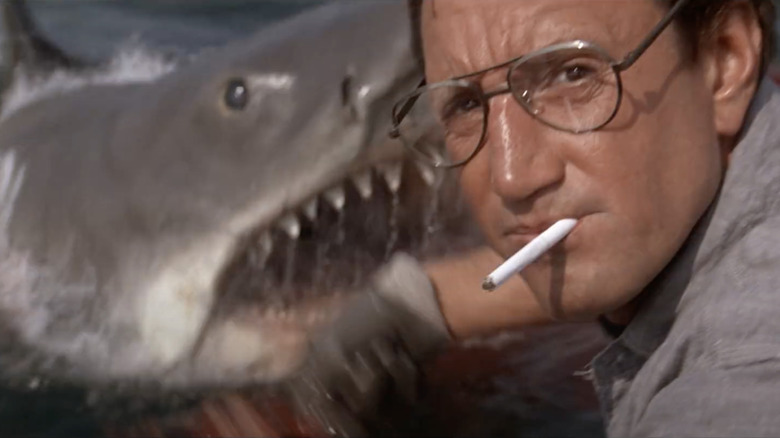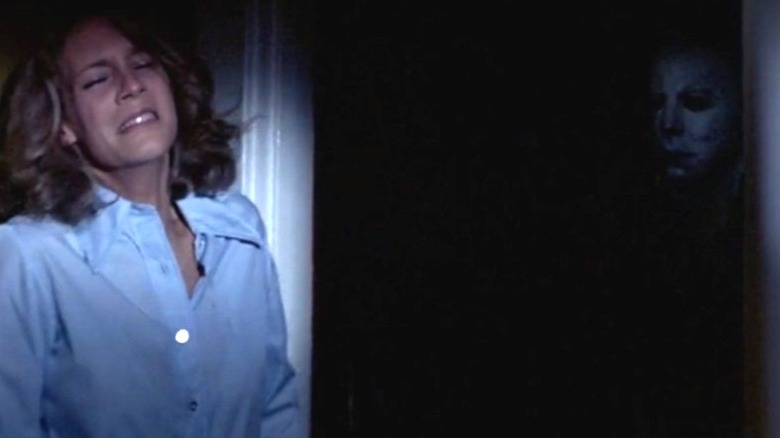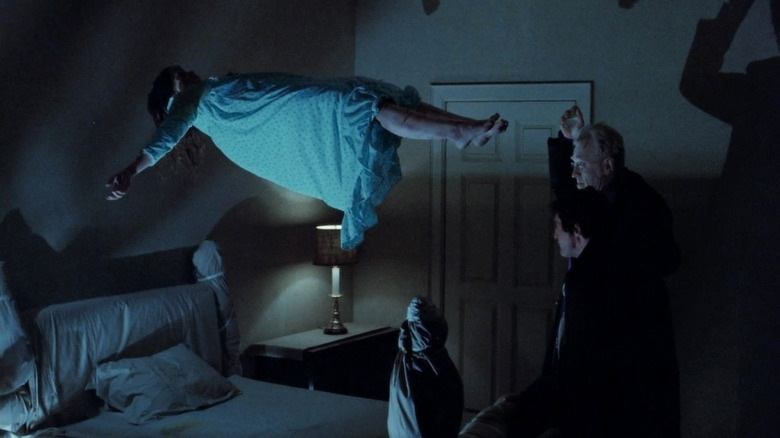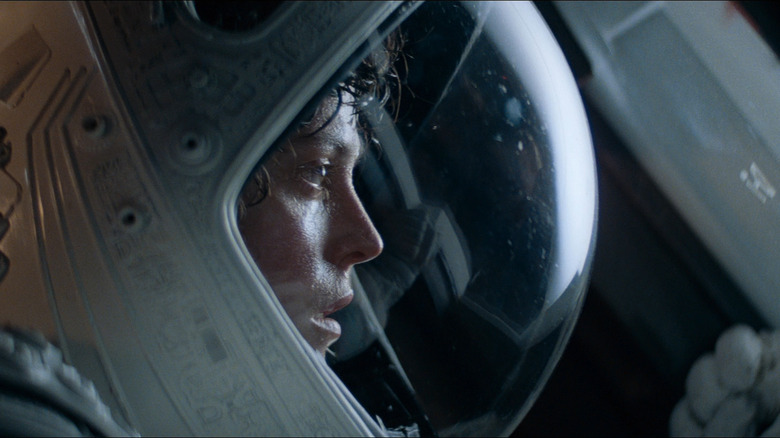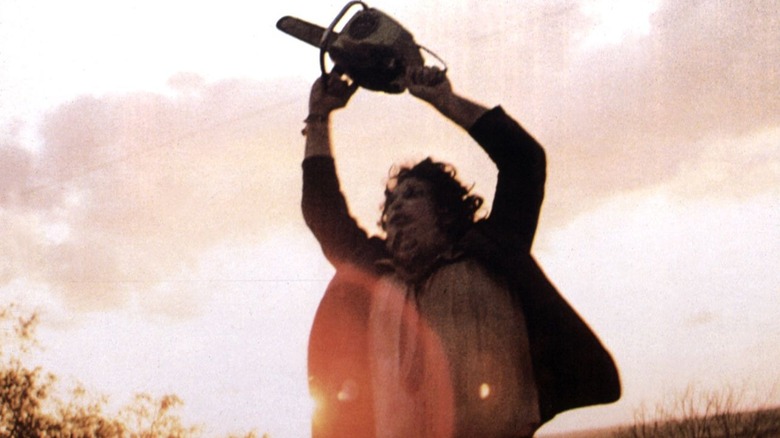The 20 Best '70s Horror Movies Ranked
The '70s was a decade marked by social and political upheaval, including the Nixon and the Watergate scandal, the Vietnam War and the antiwar movement, the fight for women's liberation and civil rights, and a conservative backlash to the freewheeling counterculture that began in the '60s. With so much happening on the cultural front, it's no wonder that the '70s was a peak era for cinema, and an incredible decade for horror movies.
The '70s saw a slew of maverick directors forging what are still considered to be among the best and most influential horror films of all time. It was the decade that gave birth to both the slasher and to the blockbuster, and gave rise to the final girl archetype.
Given that the 10-year time span that includes multiple works from horror masters and several classics of the genre, it's extremely difficult to create a "best of" list. Any number of films could be considered the best, as many of the era's horror movies strike an intangible balance between technical and artistic achievements, with strong stories, themes, impacts, legacies, and of course, the ability to frighten us. But rank them we must, so without further ado, here are the best '70s horror movies.
20. Ganja & Hess
The '70s were a pretty psychedelic time, so it's not surprising that some of the best horror offerings of the era would also be wildly trippy. Bill Gunn's "Ganja & Hess" (1973) is one of the more phantasmagoric of the era, a landmark blaxploitation arthouse horror film that is both a singular piece of cinematic art and a surreal fever dream.
The "Hess" in "Ganja & Hess" is anthropologist Hess Green ("Night of the Living Dead's" Duane Jones), whose unstable assistant, George Meda (played by the film's writer-director, Bill Gunn), stabs him with an ancient cursed dagger. Afterward, Hess is compelled to drink Meda's blood, and when Meda's beautiful widow, Ganja (Marlene Clark), shows up, the titular pair become vampiric lovers. "Ganja & Hess" is a fascinating film that explores themes of sex, religion, and African American identity through a stylish blend of horror and fantasy. It remains a cult favorite.
19. Demons
Perhaps less psychedelic but equally surreal is Toshio Matsumoto's expressionist-inspired nightmare, "Demons" (1971), a bleak, black-and-white affair that chronicles a vengeful exiled Samurai's descent into murder and madness.
Lesser known than some of its "vengeful samurai"-centered counterparts such as "Kwaidan" (1964) and "Onibaba" (1964), "Demons" (aka "Shura") nevertheless evokes serious feelings of darkness and dread as it follows the tale of Gengobei (Katsuo Nakamura), a cast-out warrior whose goal is to return to his clan's good graces and join the 47 ronin samurai. His servant helps him gather the 100 ryō needed as an offering. However, Gengobei falls in love with Koman (Yasuko Sanjo), a geisha who tricks him out of the money. His desire for revenge consumes him, with hauntingly grisly results. Adapted from a 19th-century Kabuki play, the performances in "Demons" are exaggerated in a similar style. The deeply contrasting shadows add to the unsettling ambiance, making "Demons" an unforgettably dramatic work.
18. Phantasm
Another singular work of '70s horror is Don Coscarelli's cult favorite "Phantasm" (1979), an imaginative low-budget classic that has endured thanks to its unshakeable imagery, uniquely nightmarish atmosphere, and its iconic villain, the Tall Man."
"Phantasm" revolves around Mike (Michael Baldwin), a 13-year-old boy who, after witnessing a series of strange events, begins to suspect that the town's mortician, the Tall Man (Angus Scrimm), is behind a string of murders. Things only get stranger as Mike recruits his big brother, Jody (Bill Thornbury), and the local ice cream man, Reggie (Reggie Bannister), to defeat the Tall Man. But first, they have to outrun his silver death sphere and the re-animated dead he conjures up as dwarves.
"Phantasm" blends sci-fi, fantasy, and horror in a story with themes centering on coming of age while confronting death, and the result is something truly unique and terrifying. /Film's Jacob Hall calls it "Horror's weirdest, wildest, silliest crown jewel."
17. Phantom of the Paradise
What would a list of '70s horror films be without a rock opera in the mix? Brian de Palma's "Phantom of the Paradise" is not simply a rock opera. It's an outrageously energetic and campy gothic glam-rock black-comedy horror musical! Does it get any more '70s than that?
Based loosely on "The Phantom of the Opera" and taking inspiration from "Faust," "Phantom of the Paradise" stars Pual Williams as evil record producer Swan (Paul Williams), who has long since sold his soul to the devil. Swan decides to steal the music of songwriter Winslow Leach (William Finley) and use it to help launch his new rock palace, The Paradise. A disfigured Leach dons a mask and cape to take revenge and stop Swan from harming the beautiful singer, Phoenix (Jessica Harper).
As an early example of Brian de Palma's directorial panache, "Phantom of the Paradise" is a fun and transgressive extravaganza that could only have happened in the 1970s.
16. The Rocky Horror Picture Show
The '70s gave us two incredible horror comedy musical extravaganzas. Next on the list is "The Rocky Horror Picture Show" (1974), the better-known cousin of "Phantom the Paradise."
Adapted by Richard O'Brien and Jim Sharman from their original theatre production "The Rocky Horror Show," which was itself a tribute to older B-grade horror and sci-fi films (and, of course, "Frankenstein"), "The Rocky Horror Picture Show" relates the strange journey of Brad and Janet (Barry Bostwick and Susan Sarandon), a naive young couple who stumble upon the estate of mad scientist Dr. Frank N. Furter (Tim Curry) one dark and stormy night after they get caught with a flat. They soon learn that the doctor is a "sweet transvestite" from the planet Transsexual (in the galaxy of Transylvania, to be precise). Soon, they engage with a whole gaggle of wild characters, including butler Riff Raff (O'Brien), his sister Magenta (Patricia Quinn), groupie Columbia (Nell Campbell), and Frank N. Furter's muscular blond male creation, Rocky (Peter Hinwood).
The ultimate cult classic, "The Rocky Horror Picture Show" is a celebration of the weird and a landmark cultural work in the realm of sexual liberation. The film has been doing "The Time Warp" and delighting midnight crowds for nearly half a century.
15. The Omen
It's hard to believe that the beloved director of "Superman" and "The Goonies" first broke through with a terrifying film about the devil. "The Omen" catapulted Richard Donner into the limelight after it became one of the highest grossing films of 1976. It stars Gregory Peck as an American diplomat who secretly adopts a baby, only to later discover that the boy, Damien (Harvey Spencer Stephens), is, in fact, the Antichrist. Yikes!
Lee Remick plays Damien's mother, and David Warner appears as a photographer who helps figure out that Damien's arrival signals the coming of the apocalypse. Clues include the arrival of a creepy nanny, an attack by a random pack of Rottweilers, and the untimely deaths of almost everyone involved. Oh, and then there's that eerie theme song, "Ave Satani," which was nominated for the Academy Award for best original song (composer Jerry Goldsmith did take home an Oscar for best original score).
14. Hausu
Nobuhiko Obayashi's wildly psychedelic Japanese cult classic, "Hausu" (also known as "House"), is a work of mad genius: part fantasy, part horror, part comedy, and pure chaos. It tells the trippy tale of a girl named Gorgeous (Kimiko Ikegami), who, along with six of her friends, gets eaten by the titular haunted house while visiting her aunt (Yōko Minamida), who turns out to be a demon that wants to steal the girls' youth and beauty.
At a basic level, "House" is a tale of innocence versus evil, infused with the antiwar themes that are a hallmark of Obayashi's work. With its hypnotic, inventive blend of childlike cheerfulness, grand guignol-style gore, and intentionally low-tech effects, it serves as a demented supernatural fairy tale and a haunted house film of the weirdest kind, featuring memorable highlights like a bloodthirsty piano and a grinning, blood-spewing, ghostly cat.
13. Eraserhead
"Eraserhead" is David Lynch's surrealist, nightmarish vision of fatherhood and domesticity. Though somewhat difficult to describe, the plot generally centers on Henry (Jack Nance), a shock-haired young man who has an alien-like baby with his girlfriend Mary X (Charlotte Stewart), a situation that he is neither thrilled about nor equipped to handle.
There are other elements to the plot. Henry receives a visit from a mysterious, smiling lady (Laurel Near) who lives inside a radiator. He is tempted by the alluring woman who lives across the hall (Judith Roberts). His head is lopped off and used to make erasers (hence the film's title). But, as a whole, it's up to the audience to decipher all of the film's disturbing metaphors.
Using black and white cinematography, industrial sounds and images, grotesque practical effects, and uncomfortable scenarios, Lynch's first feature unnerves and disturbs with an avant-garde style. "Eraserhead" became a highly influential work, with Stanley Kubrick reportedly making the cast and crew of "The Shining" watch it for inspiration. Jack Nance would later become a series regular on "Twin Peaks," another David Lynch project about parenthood gone wrong.
12. Black Christmas
Director Bob Clark clearly had a sardonic view of Christmas. Not only did he make the darkly comedic "A Christmas Story," but he also directed the cult classic Canadian horror flick, "Black Christmas." Released four years before John Carpenter's "Halloween," the yuletide-set "Black Christmas” is one of the earliest and most influential examples of a slasher, and one of the first of its kind to use the killer's first-person point of view as a device.
The plot of "Black Christmas" revolves around a mysterious killer named "Billy" who begins stalking and murdering the members of a sorority house, while occasionally calling them on the phone to harass them with obscenities. The film has progressively feminist leanings, featuring a subplot in which the protagonist, Jess (Olivia Hussey), decides to get an abortion against the wishes of her boyfriend, Peter (Keir Dullea), and a memorable turn by Margot Kidder as the brash and heavy-drinking Barb, who's not afraid to poke back at Billy's taunts.
While both "Black Christmas" and "Halloween" share similarities with Hitchcock's "Psycho," the influence of "Black Christmas" can be seen in films like "Halloween," "When a Stranger Calls," "Scream," and beyond. It's a terrific and important work that has also inspired two remakes.
11. Invasion of the Body Snatchers
Themes of paranoia and conformity run through 1978's "Invasion of the Body Snatchers," the Philip Kaufman-directed remake of the 1958 film of the same name. Donald Sutherland stars as Matthew Bennell, a San Francisco-based health inspector whose colleague Elizabeth (Brooke Adams) takes home an alien pod adorned with a pink flower. The pod promptly infects Elizabeth's boyfriend, and an under-the-radar alien invasion begins. For help, Elizabeth and Matthew turn to psychologist David (Leonard Nimoy), who remains skeptical; when creepy duplicate bodies start turning up, including that of Matthew's friend Jack (Jeff Goldblum), Matthew begins to realize that they are all in great danger.
With Jack's wife (Veronica Cartwright), Matthew and Elizabeth must find a way to destroy or outrun the pods before they are replaced by extraterrestrial pod people themselves. Kaufman's dread-soaked remake is more terrifying than the original film, and remains relevant today.
10. Don't Look Now
"Nothing is as it seems" in Nicholas Roeg's "Don't Look Now," a deeply unsettling film that examines the devastating effects of grief on a married couple. John (Donald Sutherland) and Laura (Julie Christie) travel to Venice after the accidental drowning of their daughter, Christine (Sharon Baxter). Things take an eerie turn for the grief-stricken pair when they encounter two elderly sisters (Hilary Mason and Clelia Matania), one of whom claims to be psychic and offers a warning of danger from their deceased daughter.
John dismisses the warnings at first, but his paranoia grows and he begins to see strange things, including glimpses of a red-coated figure that could be Christine. Utilizing a uniquely disorienting editing style and flashbacks and flashforwards that unnerve and disturb, "Don't Look Now" keeps viewers guessing until its shocking and memorable conclusion. Roeg's masterpiece has been cited as an influence on numerous filmmakers including Darren Aronofsky, Danny Boyle, and Lars Von Trier. In 2010, The Guardian declared it the third-best horror film of all time.
9. Carrie
Stephen King's wife Tabitha famously rescued the pages of his first published novel, "Carrie," from the trash can. Thank goodness for us that she did. And thank goodness for Brian De Palma, who directed the 1976 adaptation that is widely considered one of the best horror films of the '70s — or any decade.
In "Carrie," Sissy Spacek stars as 16-year-old Carrie White, a painfully shy girl whose religious mother, Margaret (Piper Laurie), is overbearing, controlling, and abusive. The socially awkward Carrie struggles to fit in at high school, where she is relentlessly bullied by the cool kids, including the popular Chris (Nancy Allen) and her boyfriend Billy (John Travolta). Feeling guilty, one of the nicer students, Sue (Amy Irving) convinces her boyfriend Tommy (William Katt) to invite Carrie to the prom, but they're unaware of an exceptionally cruel prank that Chris is planning.
However, as they are all about to discover, Carrie has a unique power of her own: telekinesis. Her mother's taunting prediction that "they're all gonna laugh at you" comes true, but in the end, Carrie has the terrifying last laugh.
8. Suspiria
The '70s was a prolific decade for giallo directors, including Dario Argento, whose "Deep Red" and "Bird with the Crystal Plumage" could have also made this list. His grand supernatural spectacle, "Suspiria," leans more heavily into the occult than typical giallos, which tend to stick closer to crime thrillers or murder mysteries.
"Suspiria" focuses on an American student, Suzy (Jessica Harper), who arrives at a prestigious dance academy, only to discover that it is run by a coven of witches headed by Miss Tanner (Alida Valli) and Madame Blanc (Joan Bennett). The script, co-written by Daria Nicolodi, is partially based on Thomas De Quincey's essay "Suspiria de Profundis," and the film is the first in Argento's "Three Mothers" series, which also includes "Inferno" and "The Mother of Tears."
Featuring a memorable score by progressive rock band Goblin, a color-drenched palette of vivid reds, blues, and greens, and a hauntingly bewitching ambiance, "Suspiria" is a surreal yet visceral feast for all senses.
7. Dawn of the Dead
The father of the zombie movie, George A. Romero, rewrote the rules of horror and established the modern zombie film with "Night of the Living Dead," then kicked it up a notch 10 years later with its spiritual successor, "Dawn of the Dead."
Larger in scope, gorier, and funnier than its predecessor, "Dawn of the Dead" begins with a live newscast of the zombie apocalypse, and follows two of the station employees (David Emge and Gaylen Ross) as they team up with a pair of SWAT officers (Ken Foree and Scott Reiniger) and fly a helicopter to a nearby shopping mall, where they make a bloody stand against the mindless undead hordes.
Romero fan and fellow director Dario Argento helped fund the film and worked with Romero on the story, which has plenty to say in its scathing critique of capitalism and consumerism, which remains as relevant as ever today. Regarding the zombies that became his calling card, Romero has said, "All I did was I took them out of 'exotica' and I made them the neighbors."
6. The Wicker Man
Folk horror is experiencing something of a resurgence thanks to films like Robert Eggers "The Witch" and Ari Aster's "Midsommar," the latter of which pays direct homage to a defining masterpiece of the genre, Robin Hardy's "The Wicker Man." Edward Woodward stars as police sergeant Neil Howie, who travels to a remote Hebridean island to investigate the disappearance of a young girl, only to discover that the freewheeling local islanders seem far more occupied with preparing for an upcoming pagan festival than helping him find the child.
Eventually, Howie's investigation leads him to the enigmatic Lord Summerisle (Christopher Lee) who soon reveals the terrifying true purpose for the festivities. With the clash between Sergeant Howie's strait-laced Catholicism and the wild paganism of Summerisle's inhabitants, "The Wicker Man" can be read as a statement on the perils of religion and the power of belief, and speaks to the conservative backlash to the hippie counterculture of the time. It is often cited as one of the great horror films, with the Guardian placing it at number four on its list of the best horror films of all time, and Christopher Lee naming it as his favorite of his movies.
5. Jaws
In the summer of 1975, audiences lined up around the block to see Steven Spielberg's movie about a great white shark terrorizing a resort town, marking "Jaws" as the first modern Hollywood blockbuster. When a shark attack occurs in the idyllic Amity Island enclave, the new police chief, Martin Brody (Roy Scheider), wants to close the beaches, but the mayor (Murray Hamilton) insists on keeping them open, resulting in the death of another innocent beach-goer.
The frustrated Brody eventually teams up with a young marine biologist, Hooper (Richard Dreyfuss), and a hardened fisherman, Quint (Robert Shaw), to track down the toothy beast, although they realize too late that they're "gonna need a bigger boat." Based on the novel by Peter Benchley, "Jaws" remains a cinematic classic that highlights the dangers not only of sharks, but of capitalism. It won three Academy Awards, including one for John Williams' iconic score, and is widely considered one of the greatest films of all time.
4. Halloween
Just a mention of John Carpenter's "Halloween" instantly conjures up the sound of a synth beat and the image of Michael Myers (Nick Castle) in his trademark overalls and mask, wielding a large kitchen knife as he pursues the teens of Haddonfield, Illinois. It's an iconic combo that scares us with its relentlessness — the score seems to never let up, and neither does our boogeyman, who has escaped a sanitarium and seems hellbent on murdering one teen in particular: Laurie Strode (Jamie Lee Curtis).
"Halloween" makes effective and terrifying use of its setting; its titular holiday is the perfect time for a masked killer to blend in with unsuspecting victims, especially in a seemingly idyllic midwestern town where many people probably don't lock their doors. This vulnerability, paired with Michael's unmotivated evil, helps make "Halloween" one of the great horror films, and secured Carpenter's place as a master of the genre.
3. The Exorcist
William Friedkin's religiously-skewed shocker, "The Exorcist," pushed horror to new heights and scared the hell out of audiences who flocked to see it in theaters upon its debut, surprising the studio with its popularity and becoming the highest-grossing movie of the year. Based on William Peter Blatty's novel, "The Exorcist” revolves around a demonically-possessed 12-year-old girl, Regan Macneill (Linda Blair), and the efforts of her mother (Ellen Burstyn) to save her.
This ultimately involves enlisting the assistance of two priests, the faith-questioning Father Karras (Jason Miller) and the more senior Father Merrin (Max Von Sydow), who arrive at the home drenched by streetlight in one of the movie's most famous scenes. Other memorable moments include Regan spinning her head around 360 degrees, projectile vomiting all over the place, and climbing backwards down the stairs while barking out vulgarities. It's all in an exorcist's day's work.
"The Exorcist" was nominated for 10 Academy Awards, winning for best adapted screenplay and best sound, and securing its place as one of the best horror films of all time.
2. Alien
"You still don't understand what you're dealing with, do you? The perfect organism. Its structural perfection is matched only by its hostility."
This quote from Ash (Ian Holm) in Ridley Scott's "Alien" serves as a meta-take on the film itself. "Alien" is a blend of horror and sci-fi, but it's essentially a haunted house movie set in space — and it's a perfect one, as well as one of the best horror films ever made.
The film follows the crew of the Nostromo as they are pulled out of stasis due to a distress signal from a nearby moon, where they discover a garden of egg-like objects. A face-hugging creature bursts out of one of them and attaches itself to crew member Kane (John Hurt). The crew brings Kane and the creature on board, a decision they soon regret: The facehugger is only the first stage in the alien's life cycle. After it finds a host, it evolves into a "chestburster," and finally a large and powerful Xenomorph.
Much about "Alien" is iconic, including the alien itself (designed by H.R. Giger), the infamous chestburster scene, and the ship's cat, Jonesy. The whole cast is stellar, but it's the strong protagonist in officer Ellen Ripley (Sigourney Weaver) that is perhaps the most iconic element of all, setting the standard for all female action heroes who followed.
1. The Texas Chain Saw Massacre
1974 saw the release of a simple film about a boy and his chainsaw, and the horror genre was made all the better for it. Tobe Hooper's "The Texas Chain Saw Massacre" is a film of raw terror, inspired by Hooper's time as a documentary cameraman, during which he determined that humans are the world's real monsters.
Presented as a true story, "The Texas Chain Saw Massacre" documents the journey of five friends, including Sally Hardesty (Marilyn Burns) and her brother Franklin (Paul A. Partain), whose idyllic summer drive descends into a horrifying ordeal when they stumble upon the home of a cannibalistic family that includes Leatherface (Gunnar Hansen), a meaty man with a mask made of skin and an affinity for chainsaws.
A frenetic energy continues to build as the unfortunate friends encounter increasingly terrifying scenarios, and the family attempts to turn them into good ol' Texas barbecue. It's a living nightmare from which neither they nor the audience can wake up. Hooper's film serves as an allegory for the Vietnam war, made in part as a reaction to and statement on post-Vietnam disillusionment. It's also a seminal work of horror, influencing directors like Ridley Scott and Wes Craven, who said that "whoever made this must have been a Mansonite crazoid."
